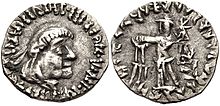Strato III
| Strato III | |
|---|---|
 Coin of Strato II and Strato III. Obv: Probable bust of Strato II. Possible Greek legend: ΒΑϹΙΛΕΩΣ ϹΩΤΙΡΟϹ ϹΤΡΑΤΩΝΟϹ ΚΑΙ ΦΙΑ / ϹΤΡΑΤΩΝΟϹ "Of Kings Strato the Saviour and Strato the Father-loving".[1] Rev: Kharoshthi legend: MAHARAJASA TRATARASA STRATASA, POTRASA CASA PRIYAPITA STRATASA "King Strato the Saviour, and his son/grandson Strato the Father-loving. | |
| King of Gandhara | |
| Reign | 25 BCE – 10 CE |
Strato III Philopator (
Coinage
Strato III may also have issued coins on his own, but these are rare and unconfirmed.[4] A few silver coins with a different portrait and the inscription Strato Soter Dikaios ("the just") may also belong to Strato III as sole ruler, or to a fourth king named Strato.[5][n 1]
Just like the earlier king Strato I, Strato III is thought to belong to the dynasty of
The chronology of the late Indo-Greek kingdom has been established by
Strato II, Strato III and Strato Dikaios struck debased silver drachms, which as mentioned portray Pallas on the reverse. Strato II appears as an old man with a sunken jaw on some of his coins, which is not surprising given that his grandson was co-regent. Strato II also issued bronzes and even lead coins of the common type Apollo/tripod. On some of Strato II's silver drachms the letter sigma is written as C, a not uncommon trait on late Hellenistic coins in the east.
Imitations by Indo-Scythian rulers
Subsequent Indo-Scythian rulers, who replaced the Stratos in their territories, designed their coins in direct imitation of those of Strato II and Strato III. This is the case of the Northern Satraps, who ruled in the territories from Sagala in Eastern Punjab to Mathura, such as Rajuvula.[2]
Just as the
See also
Notes and references
Notes
- ^ Given that the coins of Strato I have lately been attributed to two different kings, there may actually have been as many as five kings named Strato.
References
- ^ Rapson, E.J. (1906). "Coins of the Graeco-Indian sovereigns agathokleia, Strato I Soter, and Strato II Philopator". Corolla Numismatica. Numismatic essays in honour of Barclay V. Head. With a portrait and eighteen plates. Oxford.
{{cite book}}: CS1 maint: location missing publisher (link) At the Internet Archive. - ^ a b c The Dynastic Arts of the Kushans, John M. Rosenfield, University of California Press, 1967, p.135 [1]
- ^ R.C. Senior, Indo-Scythian coins and history. Volume IV. The Greek legend clearly implies that the two kings were father and son, and Senior dismisses the older reading "grandson" on the Kharosthi legend.
- ^ Coin India gallery Coin India Strato II and III
- ^ Senior, ibid.
Bibliography
- Whitehead, R.B. (1914). Catalogue of coins in the Punjab museum, Lahore. Vol. I Indo-Greek Coins. Oxford.
{{cite book}}: CS1 maint: location missing publisher (link) At the Internet Archive.
